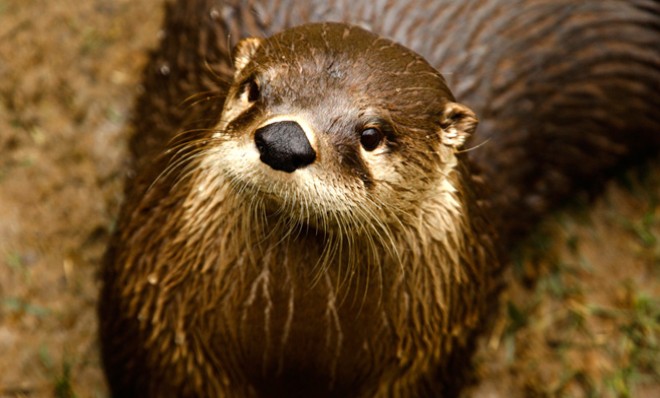Otters' penises are shrinking — and why yours might be too
These semi-aquatic animals are adorable yardsticks of what our polluted environments can do to us


The otter may have captured the internet's collective heart, but back home, his swagger has been cut down to size. According to a new report, the otter's penis bone is shrinking. The likely cause? Pollutants that make their way into the rivers the adorable animals call home. And while the otter's physical makeup is wildly different from that of a human (human males don't even have a penis bone, for example), the animal's exposure and reaction to pollutants are good indicators of the effect the environment could also have on men. Should you be keeping a keen eye on your manhood too?
Over the past few decades, things were looking up for otters, particularly those residing in England. In the 1970s, the U.K. otter population had suffered a drastic drop because of persistent organic pollutants (POPs) in rivers. But those contaminants were soon banned, and the semi-aquatic creatures eventually returned.
Inspired by that initial die-off, members of Team Otter at the Cardiff University have been studying the effects of pollutants on the English otter population for more than two decades. The researchers are now finding a host of dire things wrong with the animals' male reproductive organs. In the most recent study, they conducted post-mortem examinations on some 2,000 otters from all over the U.K. and found a decrease in penis bone weight over time, more cysts on the tubes that carry sperm during reproduction, and an increase in undescended testicles.
The Week
Escape your echo chamber. Get the facts behind the news, plus analysis from multiple perspectives.

Sign up for The Week's Free Newsletters
From our morning news briefing to a weekly Good News Newsletter, get the best of The Week delivered directly to your inbox.
From our morning news briefing to a weekly Good News Newsletter, get the best of The Week delivered directly to your inbox.
What's troubling about the study is that POPs aren't to blame this time around. Just as reproductive issues in otters have risen, the presence of POPs has only decreased over time. Instead, a host of new chemicals have taken their place.
Scientists are pointing the blame at another contributing pollutant, endocrine disruptor chemical. EDCs, also known as hormone-disrupting chemicals — found in plastic bottles, metal food cans, detergents, food, toys, cosmetics, and pesticides — have an extensive rap sheet. A 1990 study of male mice living in EDC-infested areas revealed the rodents had lower testis weights than those in non-polluted sites. In 1996, researchers found that in a lake where concentrations of EDC-riddled insecticides were high, the inhabiting alligators had penis sizes 24 percent smaller than alligators in other lakes.
While this current study did not set out to examine the effect of EDCs on the male reproductive organs of otters, scientists say that it is likely the pollutants are to blame and that further focused research needs be conducted.
How does this relate to you, dear male human? Well, it's worrying because the EDCs that may be wreaking havoc on otters have long proven dangerous to humans. As Liat Clark at Wired explains:
A free daily email with the biggest news stories of the day – and the best features from TheWeek.com
The infamous Yu-Cheng Incident of 1978 and 1979, when a batch of rice bran oil was contaminated with [EDCs], had devastating consequences for around 2,000 people, both physical and cognitive. For those male children affected prenatally, penis size was significantly reduced compared to those unaffected. [Wired]
And it doesn't end there. A series of previous studies link EDCs with low sperm count in humans. In general, since the 1970s, human males have also seen increases in testicular cancer and a rise in male birth defects, for which EDCs are a possible explanation. And before you go thinking, "no way, man, not me," Bisphenol A, a type of EDC, is ever-present, reportedly showing up in more than 90 percent of the population.
What can we do about this (cough) sensitive information? Scientists who worked on the study suggest broadening the pollutants currently under surveillance to include not only banned substances, like POPs, but also those currently and widely used. Ultimately, they say it's time to face the facts. "This study has raised a warning flag. In reality humans and wildlife are exposed to a cocktail of many chemicals every day and some may be adding up to cause problems," Gwynne Lyon, director of CHEM Trust, the company that ordered the otter study, told the Telegraph. "It is time to end the complacence about the effects of pollutants on male reproductive health."
Sources: BBC, CBS News, CHEM Trust, Fast Company, Wired
Lauren Hansen produces The Week’s podcasts and videos and edits the photo blog, Captured. She also manages the production of the magazine's iPad app. A graduate of Kenyon College and Northwestern University, she previously worked at the BBC and Frontline. She knows a thing or two about pretty pictures and cute puppies, both of which she tweets about @mylaurenhansen.
-
 ‘Consistency at the ballot box isn’t nearly as meaningful to many voters here’
‘Consistency at the ballot box isn’t nearly as meaningful to many voters here’Instant Opinion Opinion, comment and editorials of the day
-
 8 musicals to see this winter, all across the United States
8 musicals to see this winter, all across the United Statesthe week recommends New shows and reconsidered productions are on the move
-
 Rob Reiner, wife dead in ‘apparent homicide’
Rob Reiner, wife dead in ‘apparent homicide’speed read The Reiners, found in their Los Angeles home, ‘had injuries consistent with being stabbed’
